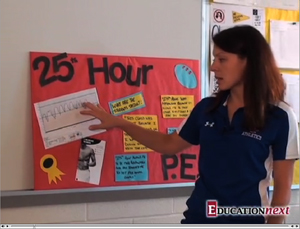In February, Michelle Obama launched her “Let’s Move” initiative, which aims to fight childhood obesity by, among other things, increasing physical education. And this spring, the U.S. House of Representatives passed a bill called the FIT Kids Act that aims to enlist schools in the war against obesity by requiring districts to report what is taking place in P.E. classes.
Are traditional P.E. classes likely to be an effective tool in fighting obesity? In a 2006 article for Education Next, “Not Your Father’s PE,” economists John Cawley, Chad Meyerhoefer, and David Newhouse investigated the likely impact of mandating more time in P.E. class. They found that “relatively little research has systematically examined how much PE (as it is currently constituted) contributes to weight loss or lowers the risk of obesity, and what little research there is finds no association between PE and weight loss and obesity.”
 One reason more P.E. has not led to weight loss might be that traditional P.E. classes do not always offer students a real workout, particularly in high school. As students and teachers explain in this new Ed Next video, students don’t like having to change into gym clothes and get sweaty in the middle of the day. So P.E. teachers may end up grading students in part based on whether they change into their P.E. clothes.
One reason more P.E. has not led to weight loss might be that traditional P.E. classes do not always offer students a real workout, particularly in high school. As students and teachers explain in this new Ed Next video, students don’t like having to change into gym clothes and get sweaty in the middle of the day. So P.E. teachers may end up grading students in part based on whether they change into their P.E. clothes.
The 25th Hour P.E. class at T.C. Williams High School in Alexandria, Virginia, featured in the new video, is different. Students enrolled in the class don’t break a sweat during the school day. Instead, they work out three times a week, before or after school. While the students are jogging, swimming, playing pickup basketball, going to soccer practice, or walking the dog, they wear monitors that track how long they exercise and whether their heart rates are in the target zone. Students meet with a P.E. teacher once a week to download the data from their monitor to her computer and discuss their workouts. Grades are based on how long students keep their heart rates in the target zone.
As students explain in the video, the grade is a powerful motivator. And the workouts that students can get outside of school may be longer and more intense than the workouts they can get during traditional P.E. classes, when valuable class time is spent changing in and out of gym clothes and showering.
Many high school students could benefit from alternative P.E. classes like 25th Hour P.E., not just those attending brick and mortar high schools. As Paul Peterson has noted, one of the most popular courses at Florida Virtual School is physical education. It is not hard to see the benefits of offering physical education classes online when simple tools like heart rate monitors enable teachers to hold students accountable.


